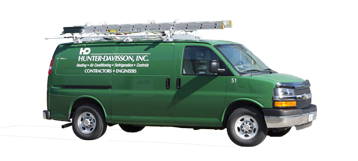Preventative maintenance is extremely beneficial for the longevity and health of a variety of things. Just like an annual visit to the doctor, a monthly tune-up for the family vehicle or brushing your teeth twice a day; HVAC equipment is no different. Regular maintenance schedules can reduce energy costs, extend the life of the equipment, and prevent costly repairs. In fact, The New Building Institute found that “best practices in building maintenance and operations reduce energy use 10 to 20 percent across all climate zones in the United Sates. In contrast, poor maintenance practices can increase energy use by 30 to 60 percent.”[1]
Your HVAC Equipment Should be Serviced Quarterly
While maintenance schedules can vary based on the size and needs of each building, we recommend preventative maintenance at least quarterly, specifically during fall and again in spring. These are optimal times of the year to perform maintenance and prepare your equipment for the approaching winter and summer, when your HVAC system is working the hardest.
HVAC Maintenance Checklist
Outdoor Units
- Inspect unit for proper refrigerant level
- Inspect coil and cabinet (clean as needed)
- Inspect base pan for restricted drain openings (remove obstructions as necessary)
- Inspect compressor and associated tubing for damage
- Clean dirt, leaves, and debris from inside cabinet
- Inspect fan motor and fan blades for wear and damage (lubricate if necessary)
- Inspect control box, associated controls/accessories, wiring and connections for wear or damage (repair if necessary)
Indoor Units
- Inspect and clean blower assembly
- On older models, lubricate and inspect and replace fan belt if needed
- Check combustion blower housing for lint and debris and clean as necessary
- Inspect evaporator coil, drain pan and condensate drain lines—clean as needed
- Inspect burner assembly (clean and adjust as needed)
- Inspect ignition system and safety controls (clean and adjust as needed)
- Inspect heat exchanger or heating elements
- Inspect flue system (check for proper attachment, dislocated sections, and for signs of wear or damage)
- Inspect control box, associated wiring and connections
- Clean or replace air filters
- Inspect conditioned airflow system (ductwork)
During Operation of Unit
- Monitor system startup and search for abnormal noises or unusual odors
- Monitor air conditioning systems for correct refrigerant charge
- Measure outdoor/indoor dry bulb temperature
- Measure high and low side system pressures
- Monitor gas furnace for correct line and manifold gas pressure (make adjustments as needed)
- Check vent system for proper operation
- Monitor system for correct line and load volts/amps
- Monitor system operation per manufacturer’s specifications
- Provide system operation report and recommend repairs/replacements as necessary
Warning: Filters are used to catch air borne particulates from entering your HVAC system. Plugged filters cause coils to freeze and build up ice—the ice melts and drips into the building resulting in water damage. It’s vital to replace the filters on your HVAC system regularly.
Not sure what’s best for your building? Give us a call and we can tailor a maintenance program that suits your needs and keeps everything running smoothly. Also, in case of emergency, our technicians are available and on-call 24/7.
[1] Frankel, M., Heater, M. and Heller, J. “Sensitivity Analysis: Relative Impact of Design, Commissioning Maintenance and Operational Variables on the Energy Performance of Office Buildings” New Buildings Institute. August 2012.
